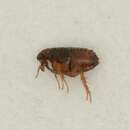en
names in breadcrumbs


Fleas can be seen in the fossil record as far back as the Middle Jurassic.They can currently be found worldwide.The adults can grow to be one to three millimeters long.They feed on the blood of mammals and birds, which makes them external parasites (ectoparasites).They are wingless and have long legs that allow them to jump horizontally for up to 33 centimeters and vertically for up to 18 centimeters.They have short antennae and spines on their body.Some species lack eyes. Fleas undergo complete metamorphosis. The blind larvae feed on organic matter and then pupate in a silken cocoon.A new adult can only survive for a week without blood, but once blood is obtained they can survive for two to three years without a meal.When hiking in a habitat that contains fleas, it is best to wear white clothing so it will be easier to spot fleas if they jump on you.